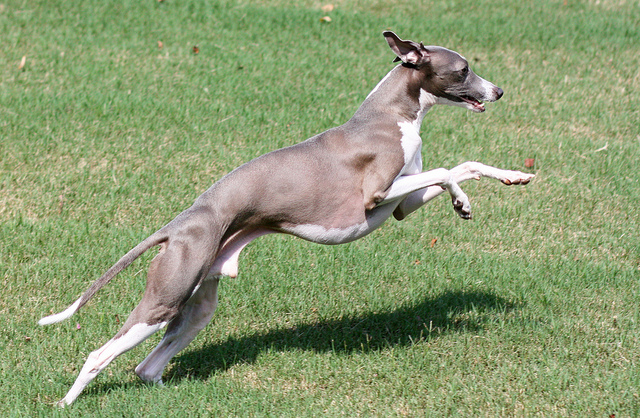
Breed
Italian Greyhound aka Iggy
Group
Toy
Physical Description
This small dog looks like a miniature greyhound and is very similar to the larger breed. The Iggy is the smallest dog of the sighthound family with a height of around one foot tall.
This smaller, slender version of the Greyhound has medium-sized, dark eyes, a long tapered tail and comes in all colors (the AKC does not allow brindle or black and tan for showing purposes).
Italian Greyhounds weigh around 10 pounds and have an average life span of 15 years, although some have been known to live close to 20 years.
Origin
Evidence of the Italian Greyhound has appeared in Egyptian tombs dating back 6,000 years. Later history shows evidence of the breed 2,000 years ago in areas that are known today as Greece and Turkey.
The dogs were sought after and adored so much by the Italians in the 16th century that they came to be known as the Italian Greyhound.
Iggys made their way to England in the 17th century and later to the United States. According to the American Kennel Club (AKC), the breed almost went extinct in Great Britain after World War I. Italian Greyhounds of superior breeding were imported from the United States to continue the breed.
The AKC recognized the breed in 1886, and the Italian Greyhound Club of America was formed in 1954.
Purpose
These dogs are companion pets, small game hunters and competitive show dogs.
Temperament
This small breed is intelligent, playful, fast and active. Italian Greyhounds prefer to stick close to their owners and can be shy with strangers. They have a desire to please their owners but might be difficult to house-train.
They can also be submissive and very timid; additionally, their fragile bones do not make them ideal for boisterous kids or large active dogs as house companions.
Some Iggys are even potty-trained since they avoid cold and water as much as possible. For additional facts and information, check out this video:

Exercise Needs
Italian Greyhounds can be pretty active indoors, so they do well in apartments. They still need a daily walk and enjoy free play and running. Take note that this breed is very sensitive to extreme temperatures and is not suited for outdoor living.
Grooming Requirements
Grooming an Iggy requires minimal effort. This breed does not shed much at all and only needs to be bathed when necessary. Many owners rub them down with a towel or chamois.
They do need regular teeth brushing and since they are prone to periodontal disease, this task should not be skipped. Weekly brushing is recommended (and daily brushing, if possible), as well as regular nail clippings and cleaning of the ears.
If you do need or decide to bathe your dog, make sure the temperature is warm — not cold or hot. Again, the Iggy is sensitive to temperatures and this includes water temperatures.
Use a gentle conditioning shampoo made only for dogs and rinse thoroughly. Any remaining shampoo residue can greatly irritate the skin. Make sure to dry the dog completely so it is not subjected to chills.
Common Health Problems
This dog breed does have a list of common health problems. While all of these may not plague your pet in particular, it’s important to observe and recognize signs of these conditions that have been seen in Iggys:
- Epilepsy
- Bone fractures
- Cataracts and eye problems (Progressive Retinal Atrophy)
- Luxating patella (slipped stifle)
- Periodontal disease
- Teeth and gum problems
- Drug sensitivities (usually anesthetics and insecticides)
- Sensitivity to extreme temperatures
- Hypothyroidism (underactive thyroid)
- Cryptorchidism (missing or retained testicles)
- Alopecia (hair loss)
- Orthopedic diseases and issues
- Immune system diseases (typically where the immune system cannot differentiate infectious cells from the Iggy’s cells and attacks the body)
- Liver shunts
- Deafness
- Von Willebrand’s disease (VWD, a blood clotting disease)
Ask to see any health tests performed before obtaining an Italian Greyhound from a breeder. If adopting from a shelter or rescue, these tests may not be available. Some conditions do not appear for several years.

Is the Italian Greyhound the Right Dog for You?
This small dog’s coat is a breeze to groom, but you should be prepared to commit to regular teeth cleaning to combat the high incidence of periodontal disease. Italian Greyhounds have fragile bones and are not recommended for very boisterous homes or large animals as they may pose a threat.
Free running and play is always enjoyed, so a trip to the dog park or a large yard would be a bonus. Although Iggys can be shy of strangers, they are affectionate and aim to please their owners. If you can handle regular teeth brushing and want a devoted companion, the Italian Greyhound might be a great fit for you.
Adopt, Don’t Buy
If you consider getting an Italian Greyhound for your next pet, check adoption resources first. Even purebred animals can end up in shelters. Try Pets Adviser’s adoption center.
If finding an Iggy through adoption resources is difficult, you can also check with rescue groups and breeders. If you do choose to go to a breeder, make sure the breeder is reputable and doesn’t exhibit any of the puppy mill warnings.
Additional Resources
- Italian Greyhound Club of America
- Italian Greyhound Club of Canada
- Italian Greyhound Club (United Kingdom)








